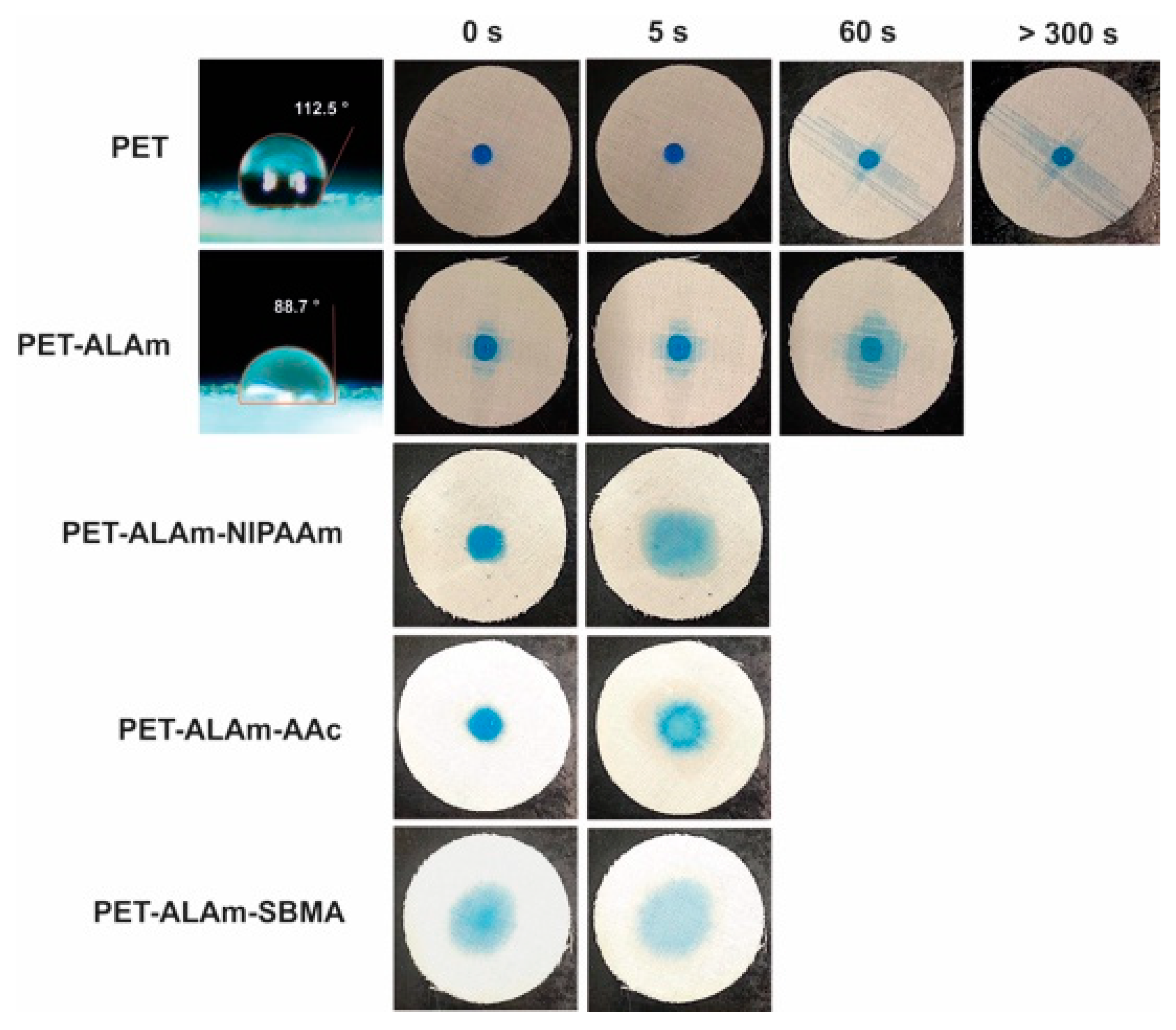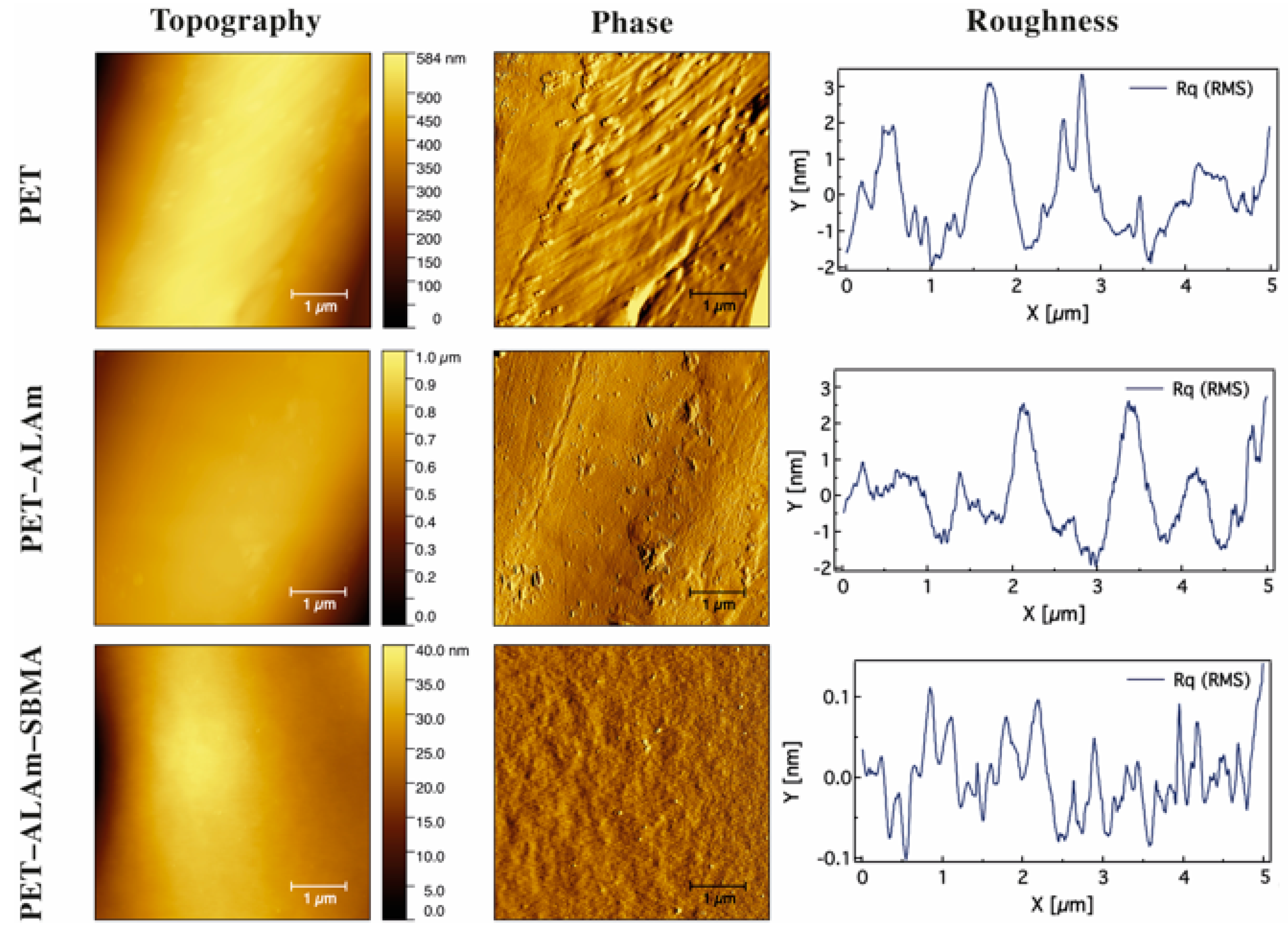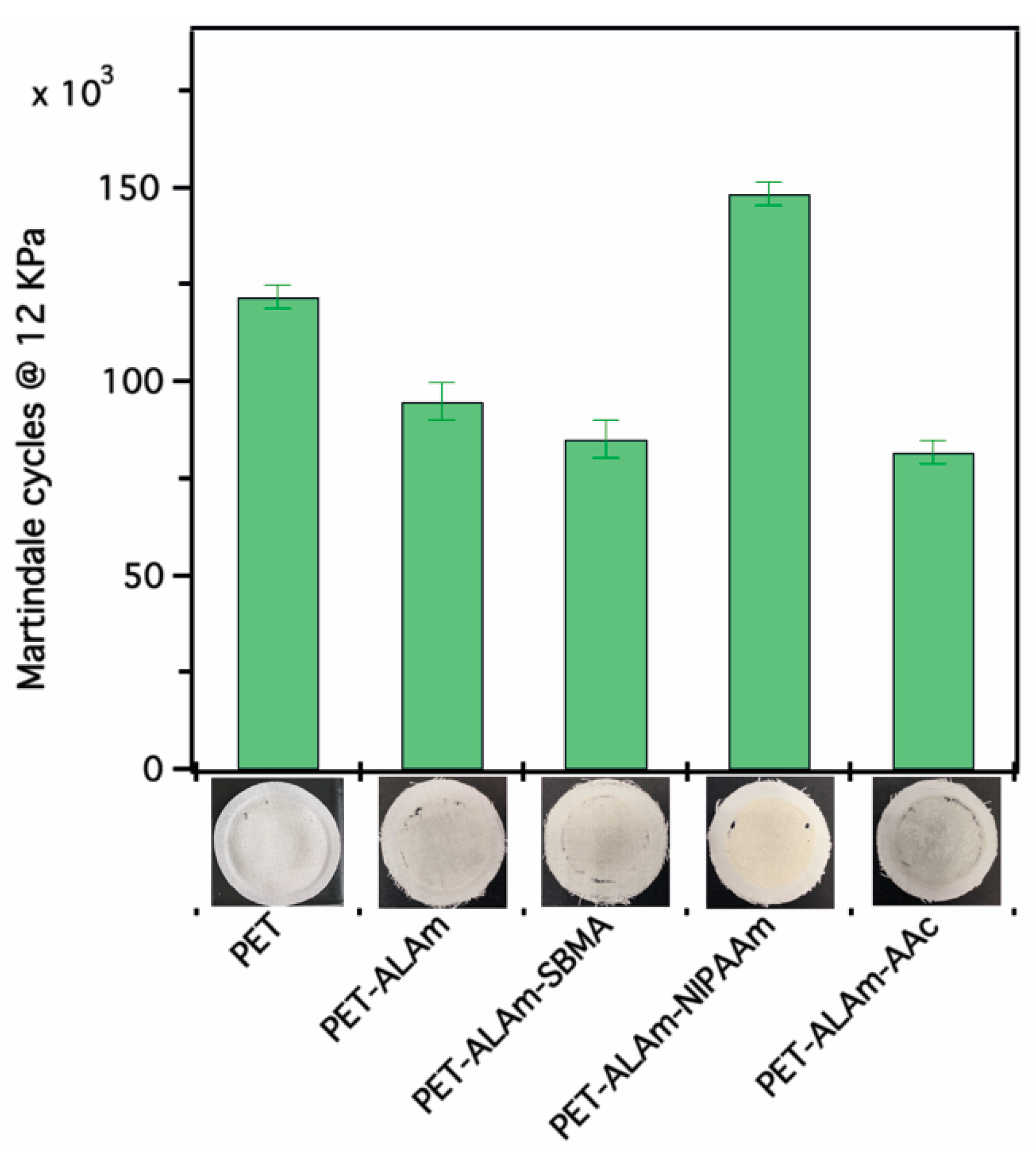Hydrogel Functionalized Polyester Fabrics by UV-Induced Photopolymerization
Abstract
1. Introduction
2. Materials and Methods
2.1. Materials
2.2. Surface Modification of PET Fabrics with Hydrogels
2.3. Characterization
3. Results and Discussion
4. Conclusions
Author Contributions
Funding
Conflicts of Interest
References
- Mittal, K.L.; Bahners, T. Textile Finishing: Recent Developments and Future Trends; Scrivener Publishing: Beverly, MA, USA, 2017. [Google Scholar]
- Fahmy, H.M.; Eid, R.A.A.; Nada, D.E.; El-Aziz, S.M.A. Functionalizaton of Linen Fabric Using Poly (N-vinyl-2-pyrrolidone). Egypt. J. Chem. 2015, 58, 447–458. [Google Scholar]
- Ballottin, D.; Fulaz, S.; Cabrini, F.; Tsukamoto, J.; Durán, N.; Alves, O.L.; Tasic, L. Antimicrobial Textiles: Biogenic Silver Nanoparticles Against candida and xanthomonas. Mater. Sci. Eng. C 2017, 75, 582–589. [Google Scholar] [CrossRef] [PubMed]
- Paul, R. Functional finishes for textiles: An overview. In Woodhead Publishing Series in Textiles; Woodhead Publishing: Cambridge, UK, 2015; pp. 1–14. [Google Scholar]
- Radetić, M. Functionalization of Textile Materials with Silver Nanoparticles. J. Mater. Sci. 2013, 48, 95–107. [Google Scholar] [CrossRef]
- Butola, B.S. Advances in Functional Finishes for Polyester and Polyamide-Based Textiles. In Woodhead Publishing Series in Textiles; Woodhead Publishing: Cambridge, UK, 2008; pp. 325–353. [Google Scholar]
- Deopura, B.L.; Padaki, N.V. Synthetic Textile Fibers: Polyamide, Polyester and Aramid Fibers. In Woodhead Publishing Series in Textiles; Woodhead Publishing: Cambridge, UK, 2015; pp. 97–114. [Google Scholar]
- Perepelkin, K.E. Physicochemical Nature and Structural Dependence of the Unique Properties of Polyester Fibers. Fiber Chem. 2001, 33, 340–352. [Google Scholar] [CrossRef]
- Timma, L.M.; Lewald, L.; Gier, F.; Homey, L.; Neyer, C.; Gutmann, S. Nonfouling Textiles with Tunable Antimicrobial Activity Based on a Zwitterionic Polyamine Finish. RSC Adv. 2019, 9, 9783–9791. [Google Scholar] [CrossRef]
- Noel, S.; Liberelle, B.; Robitaille, L.; De Crescenzo, G. Quantification of Primary Amine Groups Available for Subsequent Biofunctionalization of Polymer Surfaces. Bioconjug. Chem. 2011, 22, 1690–1699. [Google Scholar] [CrossRef] [PubMed]
- Mayer-Gall, T.; Opwis, K.; Gutmann, J.S. Polyvinylamine Modified Polyester Fibers—Innovative Textiles for the Removal of Chromate from Contaminated Groundwater. J. Mater. Chem. A 2014, 3, 386–394. [Google Scholar] [CrossRef]
- Al-Sabagh, A.M.; Yehia, F.Z.; Eshaq, G.; Rabie, A.M.; ElMetwally, A.E. Greener routes for Recycling of Polyethylene Terephthalate. Egypt. J. Pet. 2016, 25, 53–64. [Google Scholar] [CrossRef]
- Noel, S.; Liberelle, B.; Yogi, A.; Moreno, M.J.; Bureau, M.N.; Robitaille, L.; De Crescenzo, G. A Non-Damaging Chemical Amination Protocol for Poly(ethylene terephthalate)-Application to the Design of Functionalized Compliant Vascular Grafts. J. Mater. Chem. B 2013, 1, 230–238. [Google Scholar] [CrossRef]
- More, A.P.; Kokate, S.R.; Rane, P.C.; Mhaske, S.T. Studies of Different Techniques of Aminolysis of Poly(ethylene terephthalate) with Ethylenediamine. Polym. Bull. 2017, 74, 3269–3282. [Google Scholar] [CrossRef]
- Lepoittevin, B.; Costa, L.; Pardoue, S.; Dragoé, D.; Mazerat, S.; Roger, P. Hydrophilic PET Surfaces by Aminolysis and Glycopolymer Brushes Chemistry. J. Polym. Sci. Part A Polym. Chem. 2016, 54, 2689–2697. [Google Scholar] [CrossRef]
- Hoang, C.N.; Dang, Y.H. Aminolysis of Poly(ethylene terephthalate) Waste with Ethylenediamine and Characterization of a,u-Diamine Products. Polym. Degrad. Stab. 2013, 98, 697–708. [Google Scholar] [CrossRef]
- Zhou, J.; Li, M.; Zhong, L.; Zhang, F.; Zhang, G. Aminolysis of Polyethylene Terephthalate Fabric by a Method Involving the Gradual Concentration of Dilute Ethylenediamine. Colloids Surf. A Physicochem. Eng. Asp. 2017, 513, 146–152. [Google Scholar] [CrossRef]
- Ferreira, N.N.; Ferreira, L.M.B.; Cardoso, V.M.O.; Boni, F.I.; Souza, A.L.R.; Gremião, M.P.D. Recent Advances in Smart Hydrogels for Biomedical Applications: From Self-Assembly to Functional Approaches. Eur. Polym. J. 2018, 99, 117–133. [Google Scholar] [CrossRef]
- Chen, K.S.; Tsai, J.C.; Chou, C.W.; Yang, M.R.; Yang, J.M. Effects of Additives on the Photo-Induced Grafting Polymerization of N-Isopropylacrylamide gel onto PET Film and PP Nonwoven Fabric Surface. Mater. Sci. Eng. C 2002, 20, 203–208. [Google Scholar] [CrossRef]
- Ahmed, E.M. Hydrogel: Preparation, Characterization, and Applications: A review. J. Adv. Res. 2015, 6, 105–121. [Google Scholar] [CrossRef]
- Schlenoff, J.B. Zwitteration: Coating Surfaces with Zwitterionic Functionality to Reduce Nonspecific Adsorption. Langmuir 2014, 30, 9625–9636. [Google Scholar] [CrossRef]
- Azzaroni, O.; Brown, A.A.; Huck, W.T.S. UCST Wetting Transitions of Polyzwitterionic Brushes Driven by Self-Association. Angew. Chem. Int. Ed. 2006, 45, 1770–1774. [Google Scholar] [CrossRef]
- Wang, Y.; Shen, J.; Yuan, J. Design of Hemocompatible and Antifouling PET Sheets with Synergistic Zwitterionic Surfaces. J. Colloid Interface Sci. 2016, 480, 205–217. [Google Scholar] [CrossRef]
- Suradi, S.S.; Naemuddin, N.H.; Hashim, S.; Adrus, N. Impact of Carboxylation and Hydrolysis Functionalisations on the Anti-Oil Staining Behaviour of Textiles Grafted with Poly(N-isopropylacrylamide) Hydrogel. RSC Adv. 2018, 8, 13423–13432. [Google Scholar] [CrossRef]
- Pelton, R. Poly(N-isopropylacrylamide) (PNIPAM) is Never Hydrophobic. J. Colloid Interface Sci. 2010, 348, 673–674. [Google Scholar] [CrossRef] [PubMed]
- Schild, H.G. Poly(N-isopropylacrylamide): Experiment, Theory and Application. Prog. Polym. Sci. 1992, 17, 163–249. [Google Scholar] [CrossRef]
- Schulz, D.N.; Peiffer, D.G.; Agarwal, P.K.; Larabee, J.; Kaladas, J.J.; Soni, L.; Handwerker, B.; Garner, R.T. Phase Behaviour and Solution Properties of Sulphobetaine Polymers. Polymer 1986, 27, 1734–1742. [Google Scholar] [CrossRef]
- Vasantha, V.A.; Jana, S.; Parthiban, A.; Vancso, J.G. Water Swelling, Brine Soluble Imidazole Based Zwitterionic Polymers-Synthesis and Study of Reversible UCST Behaviour and Gel–Sol Transitions. Chem. Commun. 2014, 50, 46–48. [Google Scholar] [CrossRef] [PubMed]
- Sarkar, A.; Kanti, F.; Gulotta, A.; Murray, B.S.; Zhang, S. Aqueous Lubrication, Structure and Rheological Properties of Whey Protein Microgel Particles. Langmuir 2017, 33, 14699–14708. [Google Scholar] [CrossRef] [PubMed]







© 2019 by the authors. Licensee MDPI, Basel, Switzerland. This article is an open access article distributed under the terms and conditions of the Creative Commons Attribution (CC BY) license (http://creativecommons.org/licenses/by/4.0/).
Share and Cite
Lorusso, E.; Ali, W.; Hildebrandt, M.; Mayer-Gall, T.; Gutmann, J.S. Hydrogel Functionalized Polyester Fabrics by UV-Induced Photopolymerization. Polymers 2019, 11, 1329. https://doi.org/10.3390/polym11081329
Lorusso E, Ali W, Hildebrandt M, Mayer-Gall T, Gutmann JS. Hydrogel Functionalized Polyester Fabrics by UV-Induced Photopolymerization. Polymers. 2019; 11(8):1329. https://doi.org/10.3390/polym11081329
Chicago/Turabian StyleLorusso, Emanuela, Wael Ali, Marcus Hildebrandt, Thomas Mayer-Gall, and Jochen S. Gutmann. 2019. "Hydrogel Functionalized Polyester Fabrics by UV-Induced Photopolymerization" Polymers 11, no. 8: 1329. https://doi.org/10.3390/polym11081329
APA StyleLorusso, E., Ali, W., Hildebrandt, M., Mayer-Gall, T., & Gutmann, J. S. (2019). Hydrogel Functionalized Polyester Fabrics by UV-Induced Photopolymerization. Polymers, 11(8), 1329. https://doi.org/10.3390/polym11081329







